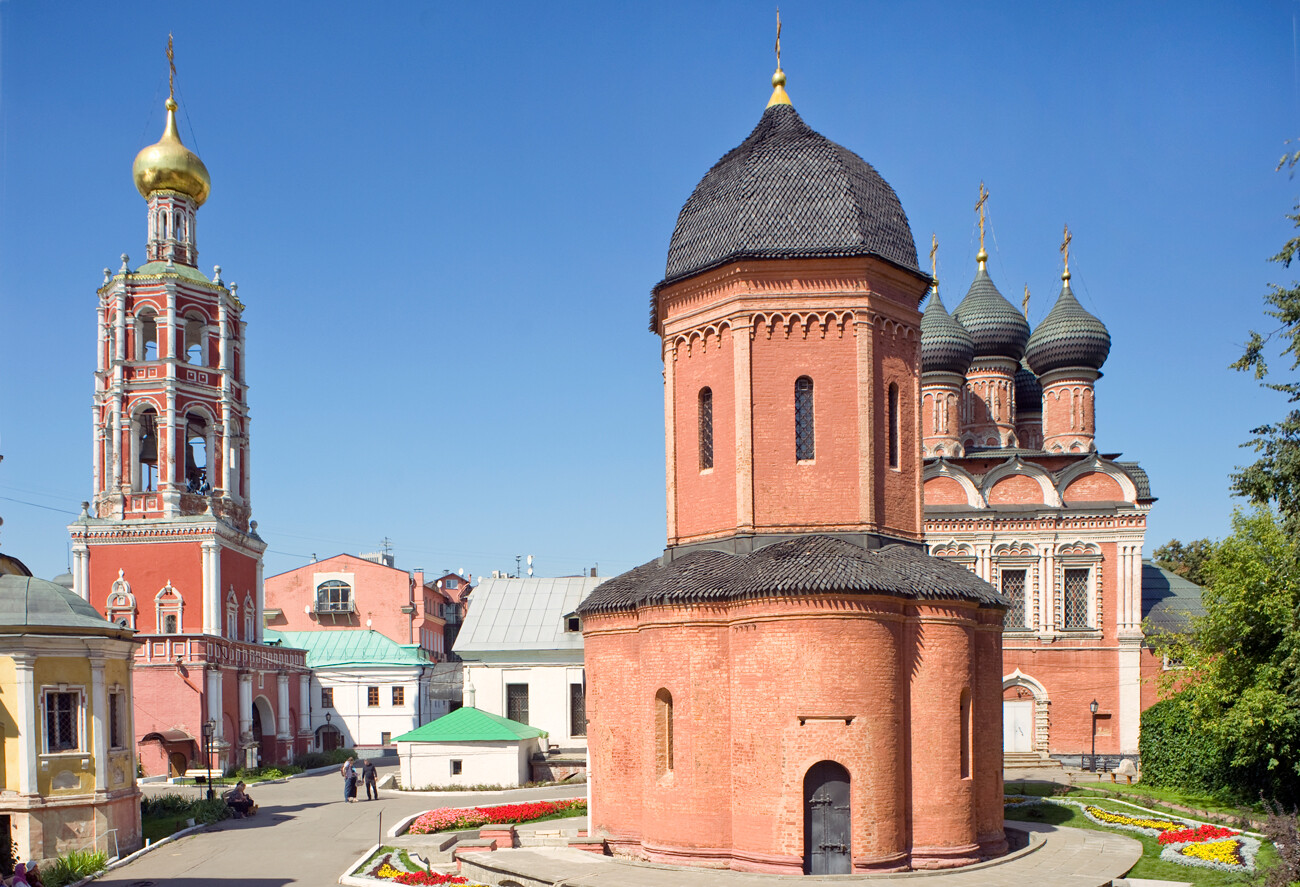
Moscow. Upper Petrovsky Monastery, south view. From left: Bell tower with Gate Church of Intercession, Naryshkin burial chapel, Cathedral of Metropolitan Peter, Cathedral of Bogoliubov Icon of the Virgin. Photo: August 22, 2015
William BrumfieldAt the beginning of the 20th century, Russian chemist and photographer Sergey Prokudin-Gorsky invented a complex process for vivid, detailed color photography. His vision of photography as a form of education and enlightenment was demonstrated with special clarity through his photographs of architectural monuments in the historic sites throughout the Russian heartland.
The main part of the Prokudin-Gorsky collection ultimately became a part of The Library of Congress (see box text below), but he also established a business that produced color postcards and illustrations in books. In 1914, his enterprise was reestablished under the name ‘Biochrome’.
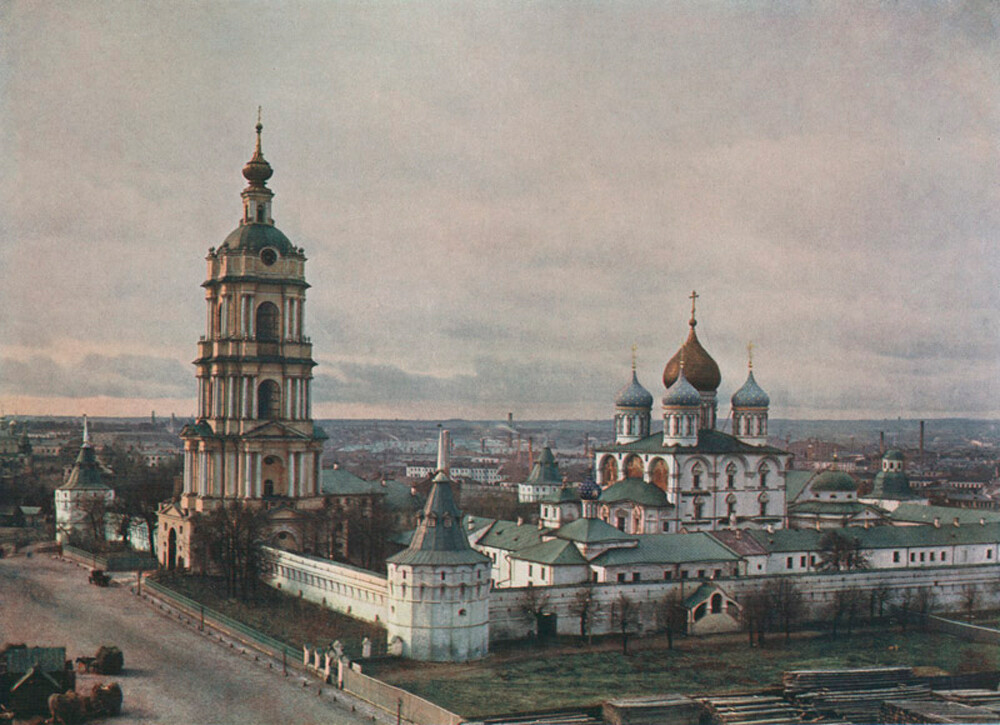
Moscow. Novospassky Monastery, northeast view with bell tower & Transfiguration Cathedral. Color print published in P. G. Vasenko, Romanov Boyars and the Enthronement of Mikhail Fedorovich (St. Petersburg, 1913) Photo: Summer 1912
Sergei Prokudin-GorskyAmong the publications with his color photographs was a large volume published in 1913 to commemorate the tercentenary of the Romanov dynasty. The illustrations included his panoramic view from a nearby rooftop of one of Russia’s most historic monastic institutions, the medieval Novospassky (New Savior) Monastery, located on a rise overlooking the Moskva River near the Kremlin.
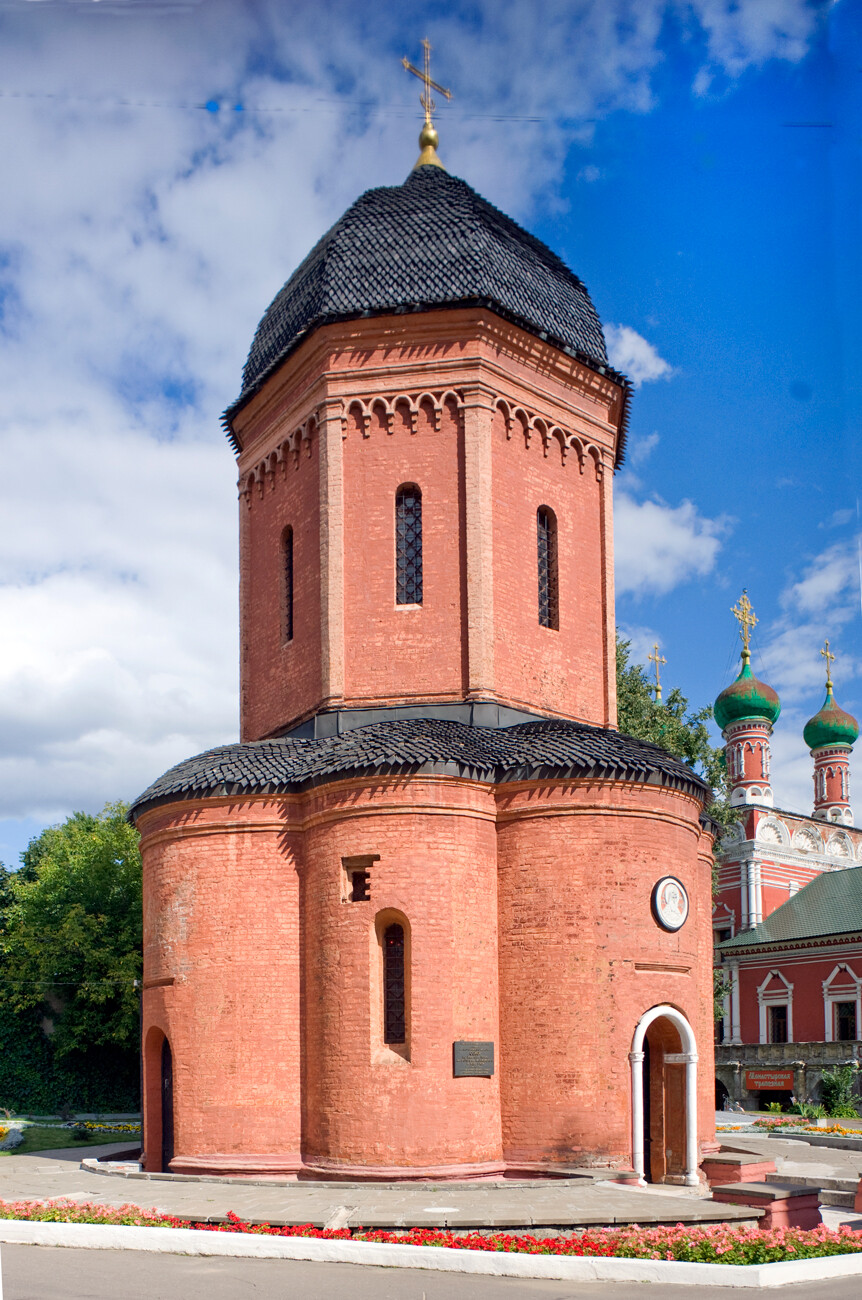
Upper Petrovsky Monastery. Cathedral of Metropolitan Peter, northwest view. Photo: August 2, 2015
William BrumfieldAlthough Novospassky is the only Moscow monastery that Prokudin-Gorsky is known to have photographed, there are similar monastic ensembles within a short distance. Among them is the Upper Petrovsky (Vysoko-Petrovsky) Monastery, which, like Novospassky, was closely connected with Russian dynastic history and particularly with Peter the Great.
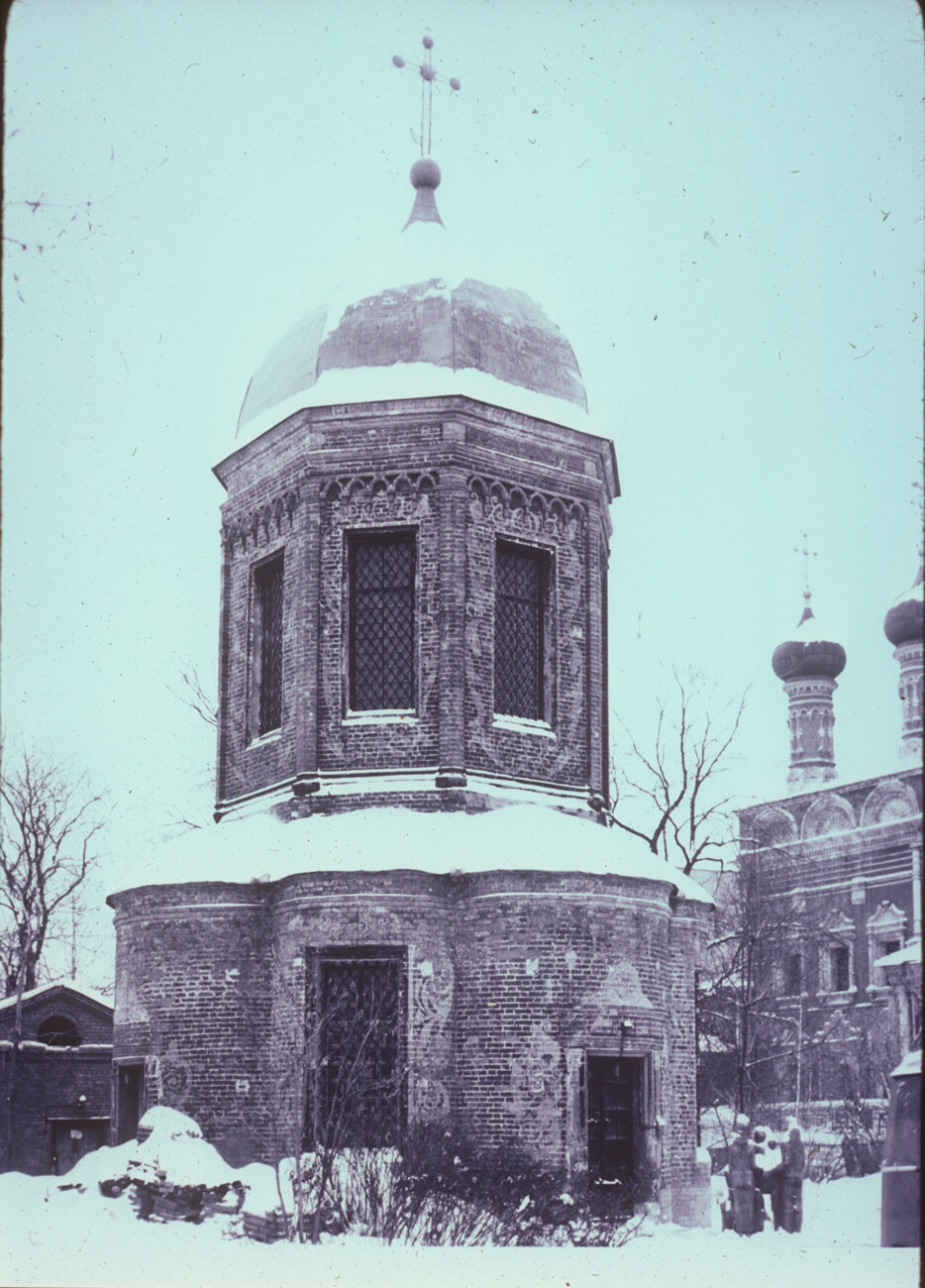
Upper Petrovsky Monastery. Cathedral of Metropolitan Peter, northwest view before restoration. Photo: December 16, 1979
William BrumfieldWith a bright, richly decorated bell tower marking the summit of Petrovka Street, it occupies a notable place in the heart of Moscow. I was fortunate to photograph it over a period of almost four decades (from 1979 to 2015).
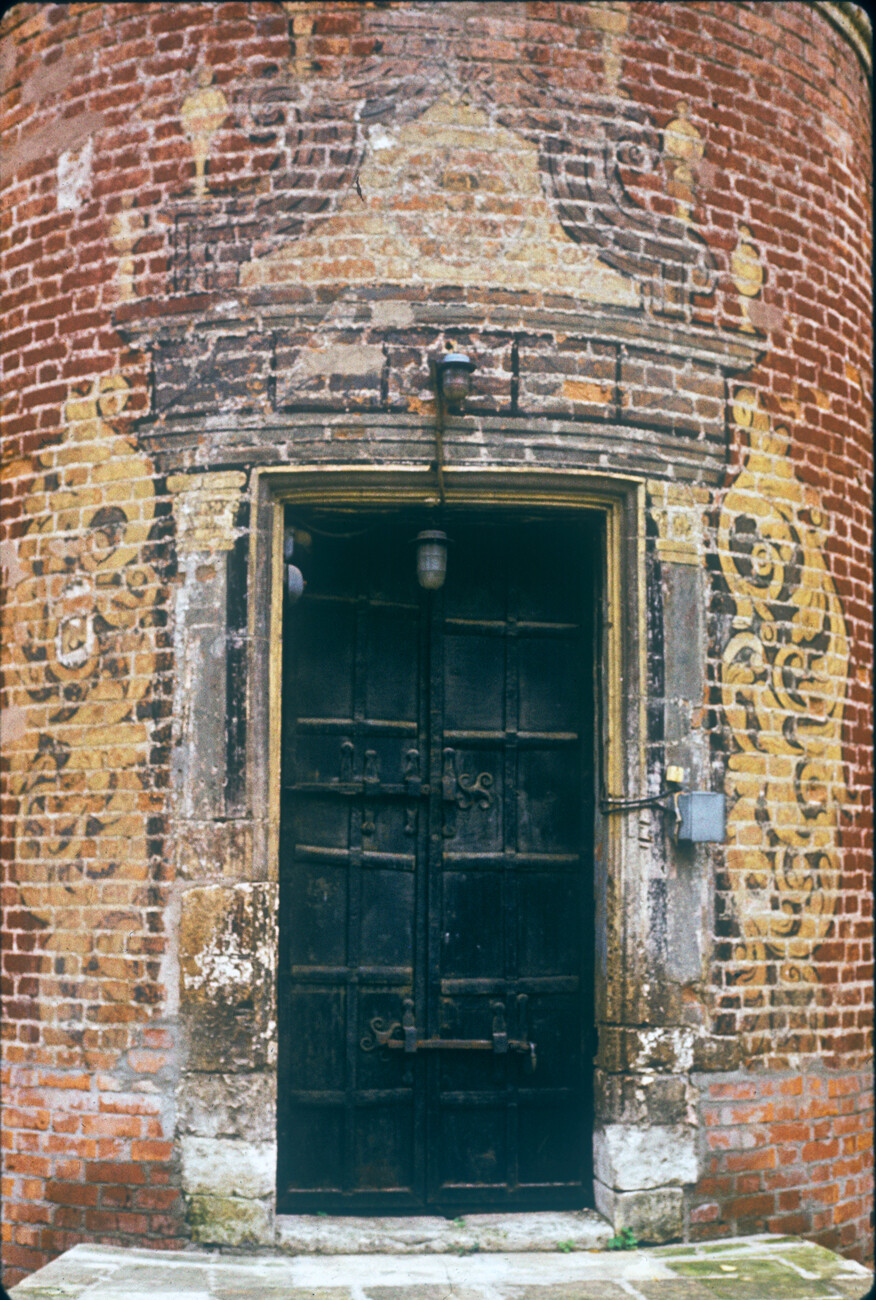
Upper Petrovsky Monastery. Cathedral of Metropolitan Peter, west facade & portal with remnants of late 17th-century painted facade decoration. Photo: October 9, 1979
William BrumfieldThere are competing versions as to when and how the Upper Petrovsky Monastery was founded, but most accounts give credit to Grand Prince Ivan I (Kalita; 1280s-1340) and to the head of the Orthodox Church, Peter, Metropolitan of Kiev and All Rus’ (1260s-1326). The Russian principalities were at that time under the control of the Mongol Golden Horde, which played various princes against each other. In the ruthless struggle for regional power, Peter began to ally himself with Ivan as early as 1315.
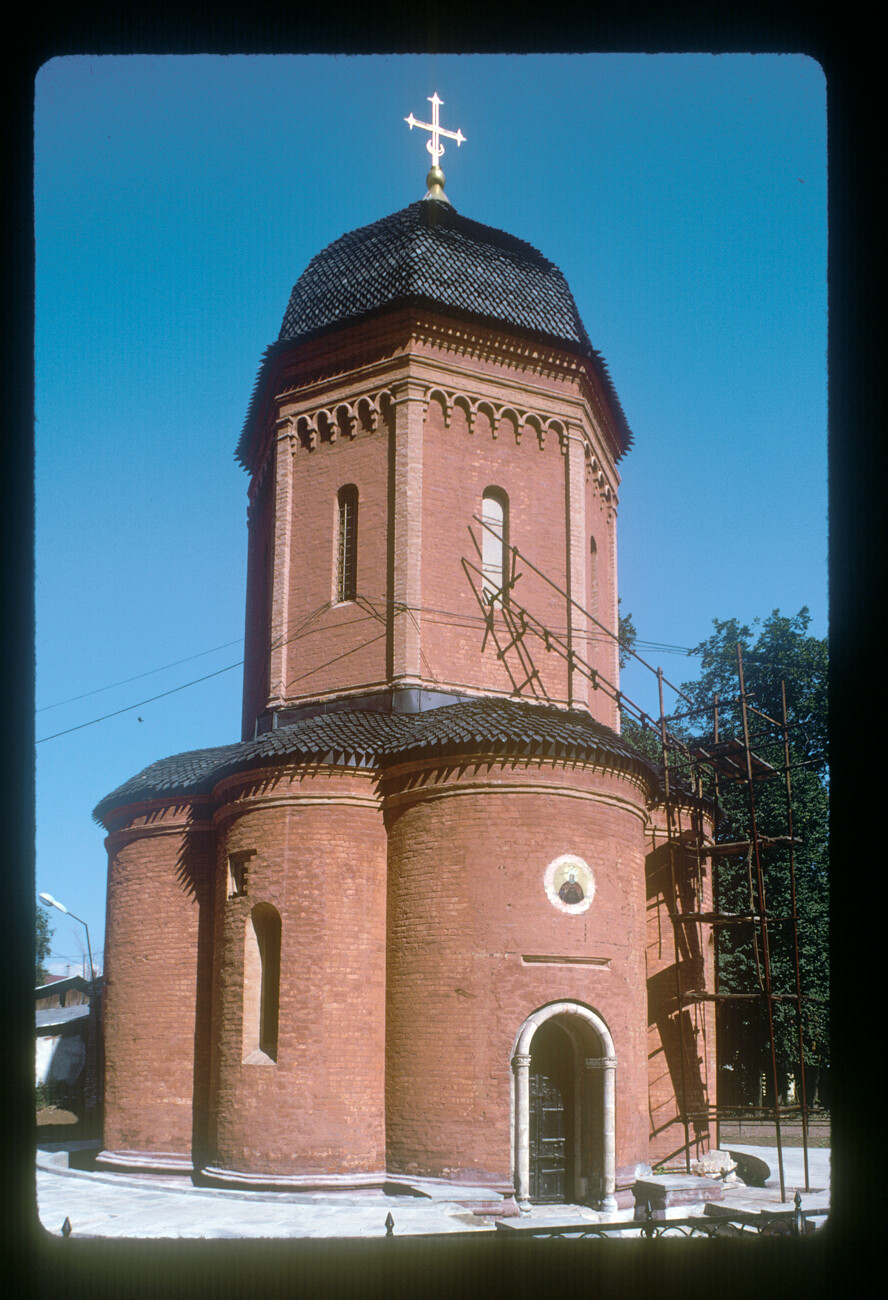
Upper Petrovsky Monastery. Cathedral of Metropolitan Peter, northwest view during restoration. Photo: August 5, 1997
William BrumfieldWhen Peter moved the residence of the Metropolitanate from the city of Vladimir to Moscow in 1325, he bestowed the church’s great spiritual authority on the small but ambitious Moscow principality. This in turn played a critical role in the further consolidation of Moscow’s political power under Ivan Kalita.
At some point – perhaps as early as 1315 or 1316, but likely in the early 1330s – a log church was built on a rise of land above the small Neglinnaya River and dedicated to Saints Peter and Paul. ‘The Medieval Book of Royal Degrees’ attributes its construction to a vision by Ivan Kalita. In any event, the dedication was intended in homage to Metropolitan Peter, who died in 1326 and was canonized in 1339.
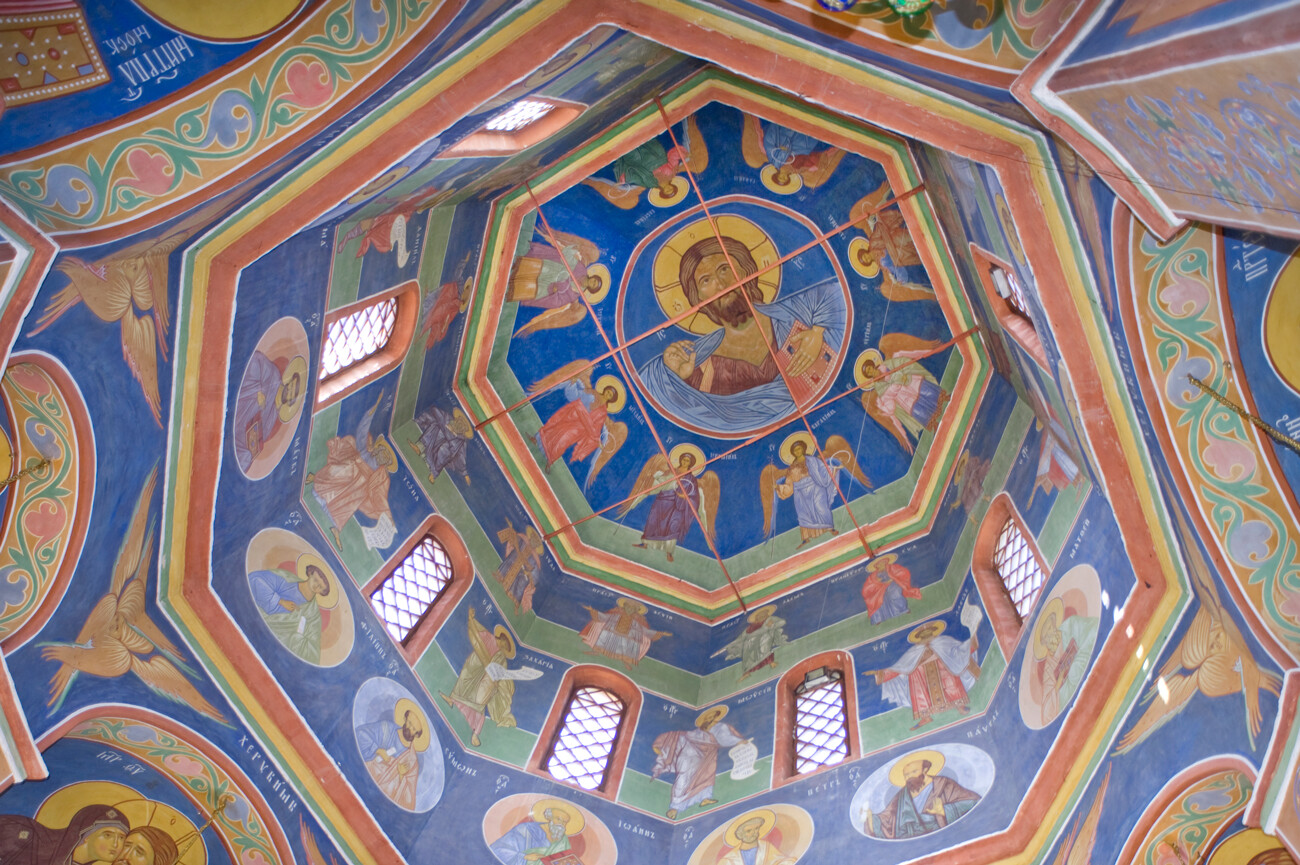
Upper Petrovsky Monastery. Cathedral of Metropolitan Peter, interior. View of dome with wall paintings of Christ & archangels. Photo: August 2, 2015
William BrumfieldThe Monastery of Saints Peter and Paul took its origins from this modest church. Another account suggests that the church and monastery – built of wood – were reconstructed by Grand Prince Dmitry Donskoy after a devastating Tatar attack on Moscow in 1382. The fire of 1493, which destroyed half of Moscow, again leveled the monastery.
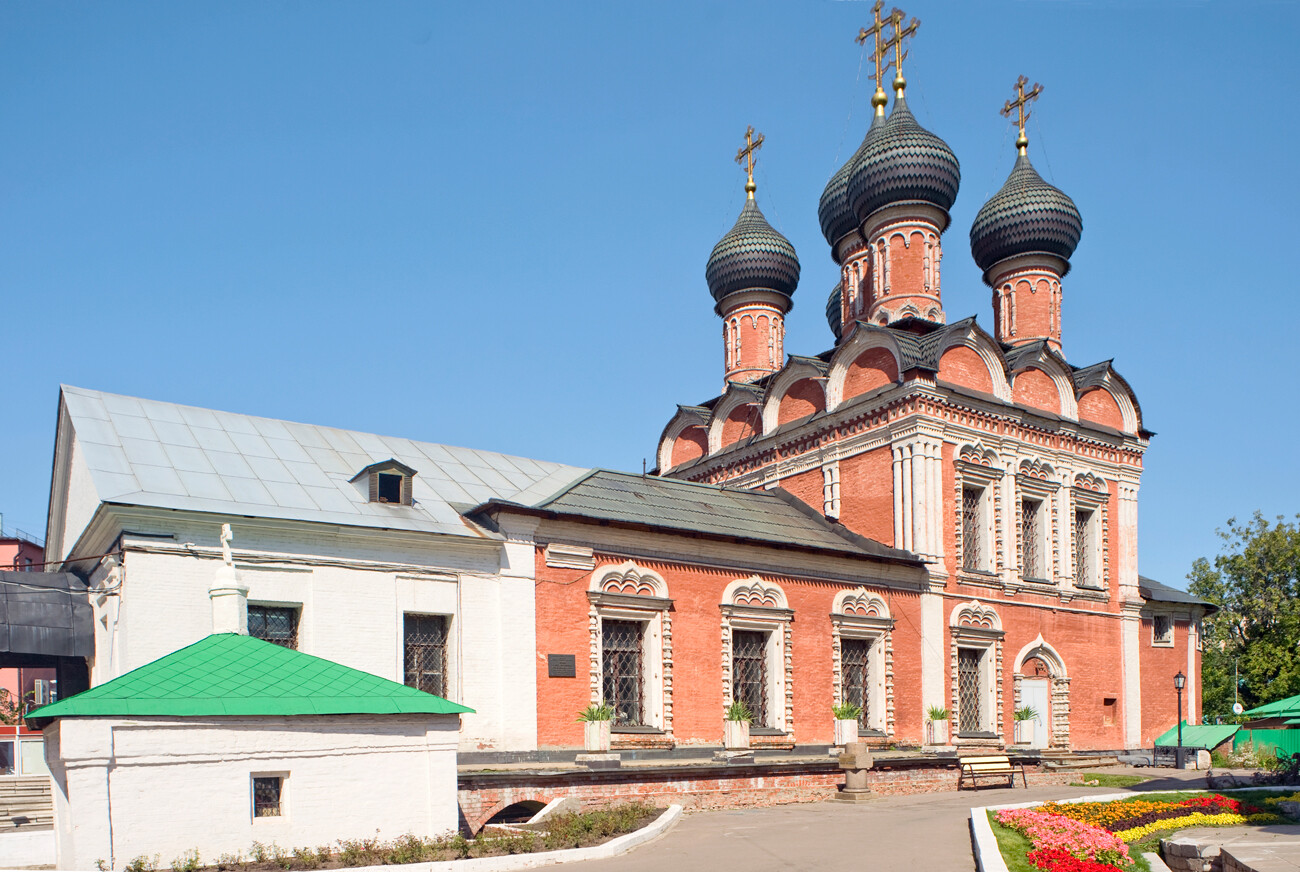
Upper Petrovsky Monastery. Cathedral of Bogoliubov Icon of the Virgin, southwest view. Left foreground: Naryshkin burial chapel. Photo: August 22, 2015
William BrumfieldAt the beginning of the 16th century the Peter-Paul Monastery gained the attention of Grand Prince Basil III, who ordered its central church to be rebuilt in brick. In August 1517, the structure was consecrated as the Cathedral of the Metropolitan Peter, and the monastery formally assumed the name of Vysoko-Petrovsky (“upper” because of its elevated location, and ‘Petrovsky’ from the name Peter).
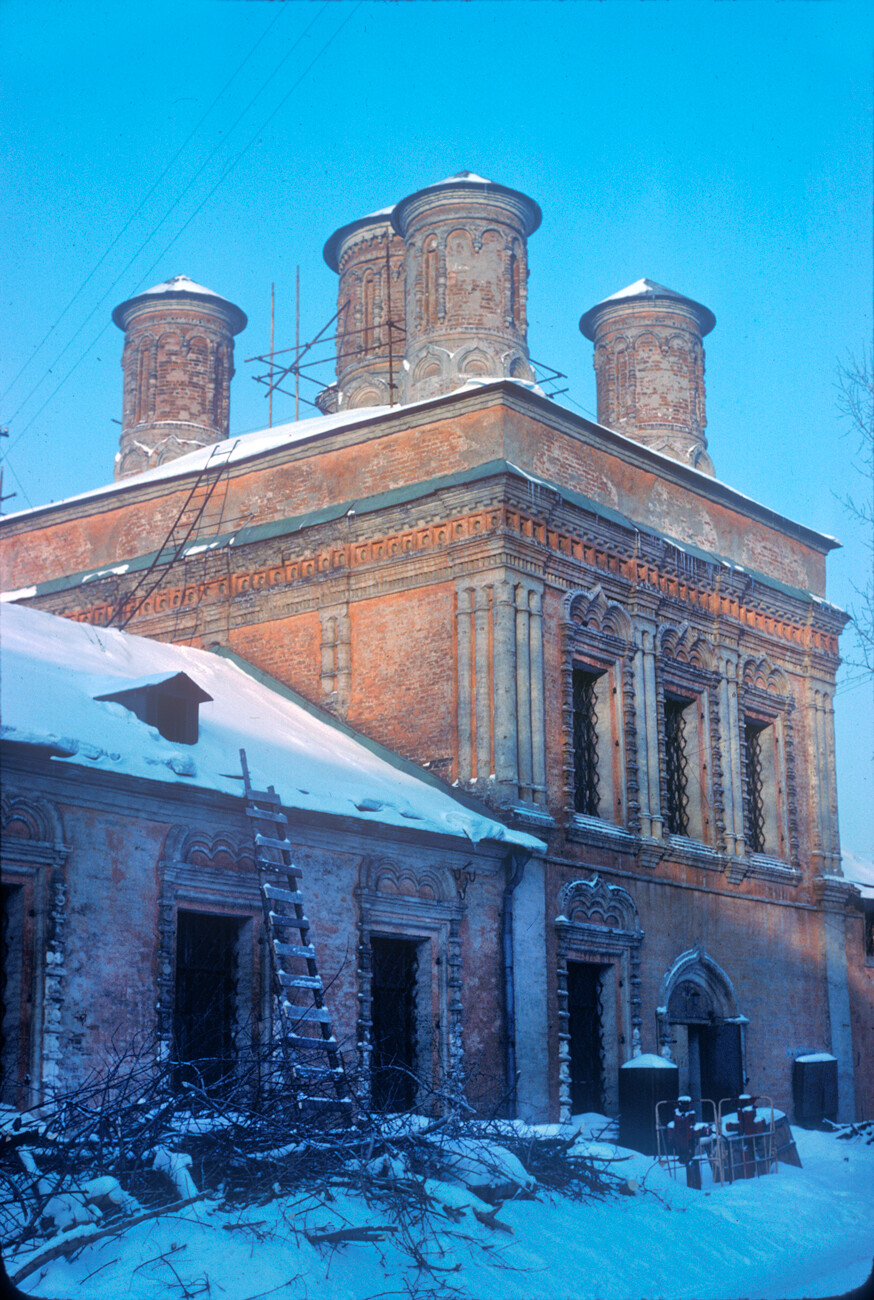
Upper Petrovsky Monastery. Cathedral of Bogoliubov Icon of the Virgin, southwest view before restoration. Photo: February 11, 1980
William BrumfieldThe architect chosen for this project was apparently the prominent Italian builder known as Aleviz Novy, author of the grand Archangel Michael Cathedral in the Moscow Kremlin. The Metropolitan Peter Cathedral is among a group of churches built by Aleviz between 1514 and 1517.
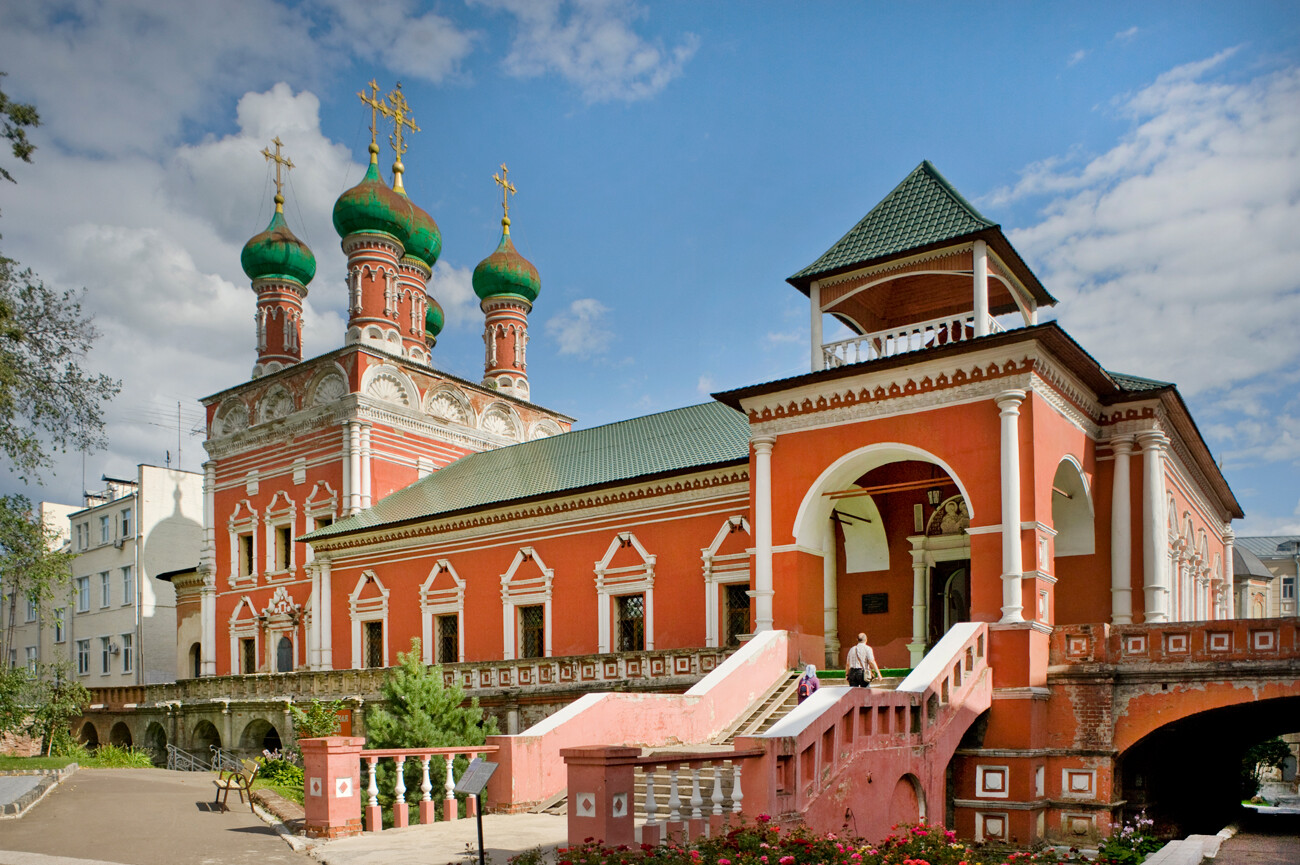
Upper Petrovsky Monastery. Refectory Church of Saint Sergius of Radonezh, northwest view. Photo: August 2, 2015
William BrumfieldThe unusual plan of the small cathedral rested on an octagonal first level, whose bays at the points of the compass were larger than those on the diagonal. The upper tier is octagonal and presumably had narrow windows in a lancet form in each of the eight bays. The structure culminated in a short arcade frieze, above which was a cornice and a helmet roof of eight facets covered in dark tile, Aleviz's preferred roofing material.
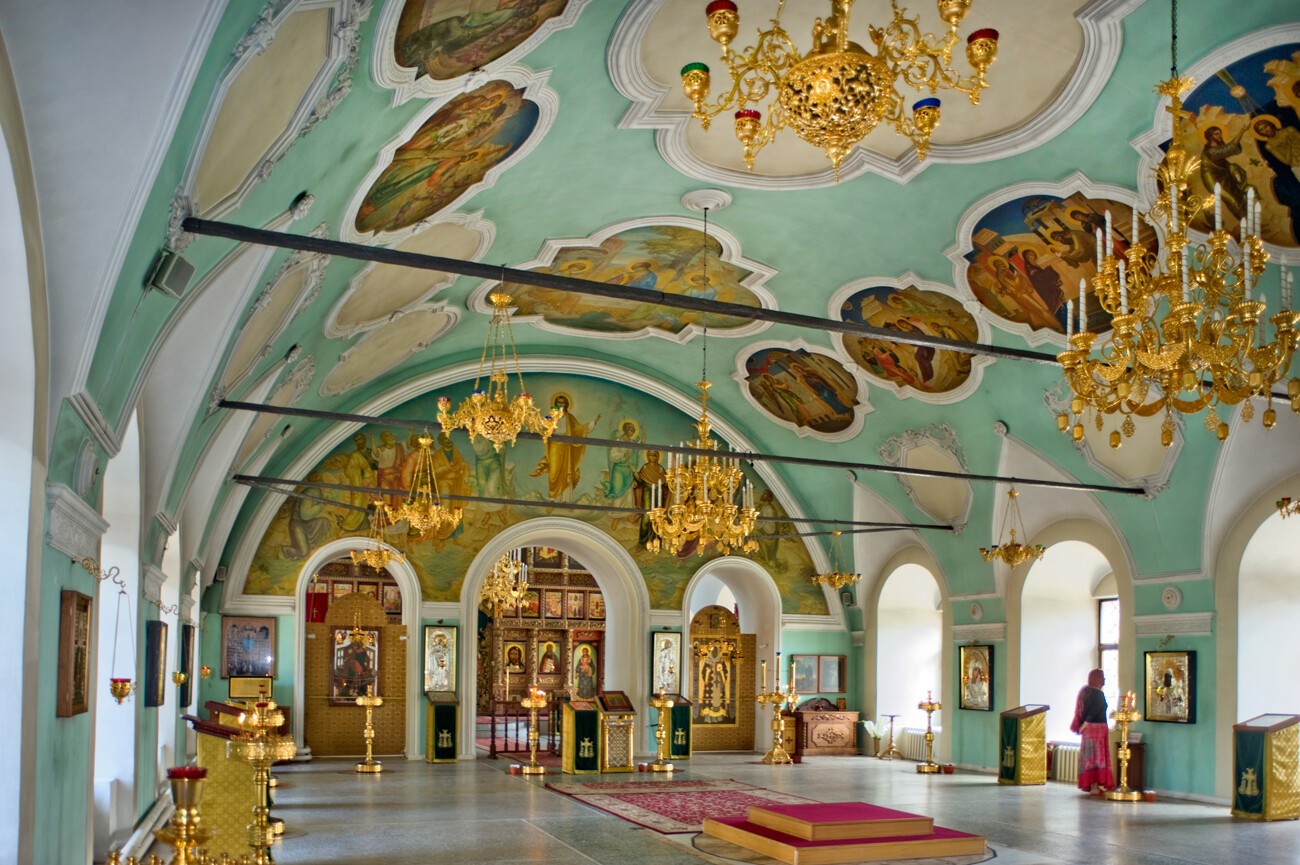
Upper Petrovsky Monastery. Refectory Church of Saint Sergius of Radonezh. Interior, view east from refectory hall. Photo: August 2, 2015
William BrumfieldOn the interior, the lobes of the octofoil provided additional space and buttressed the structure – sound enough to allow a considerable widening of the windows at the turn of the 18th century. Despite its small scale, the church prefigures the development of Moscow’s 16th-century votive churches as well as the return to highly decorated tower churches at the end of the 17th century.
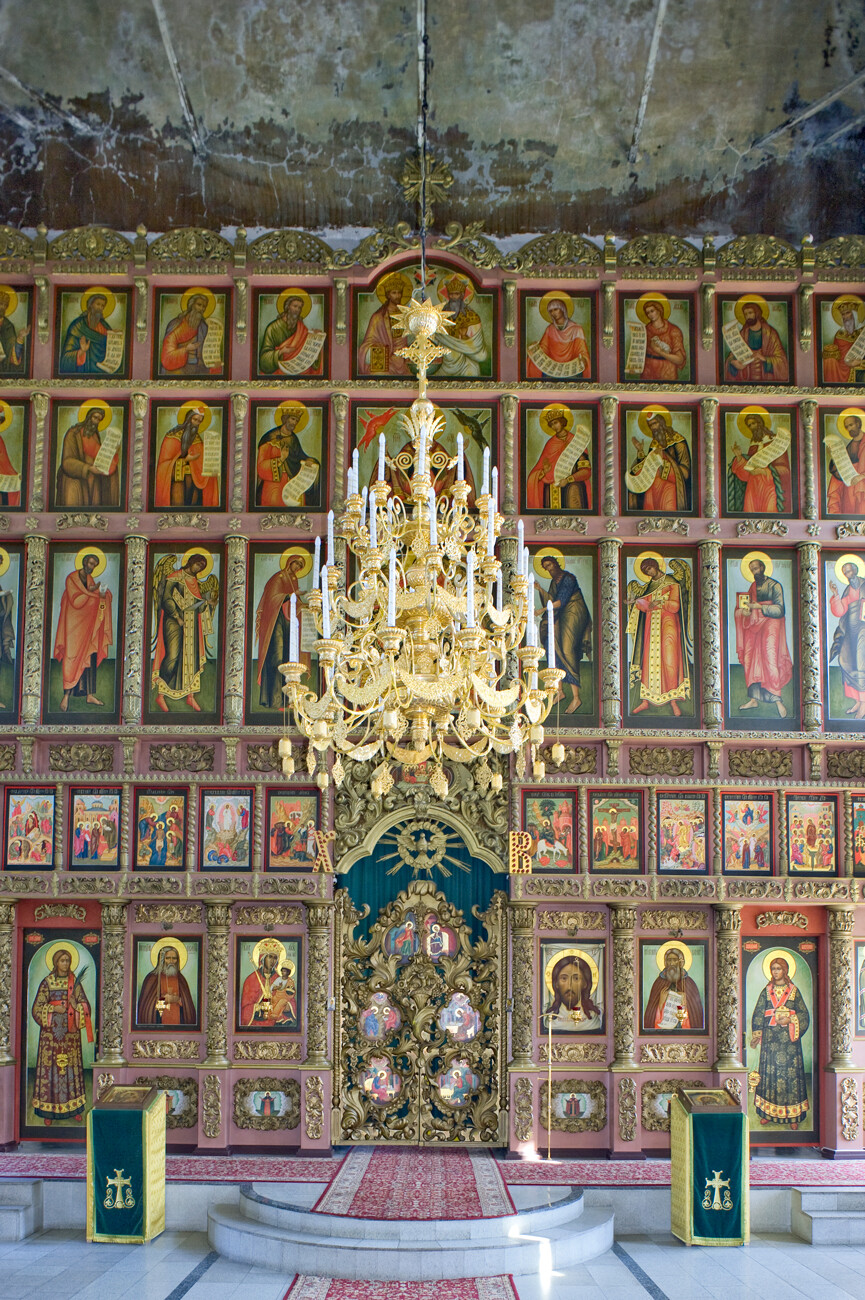
Upper Petrovsky Monastery. Refectory Church of Saint Sergius of Radonezh. Interior, view east toward new icon screen. Photo: August 22, 2015
William BrumfieldModified in the late 17th and 18th centuries, the Cathedral of Metropolitan Peter was restored in the late 20th century to what is assumed to be its original appearance. The interior has been painted with new frescoes, while the cathedral was re-consecrated for worship in 1998.
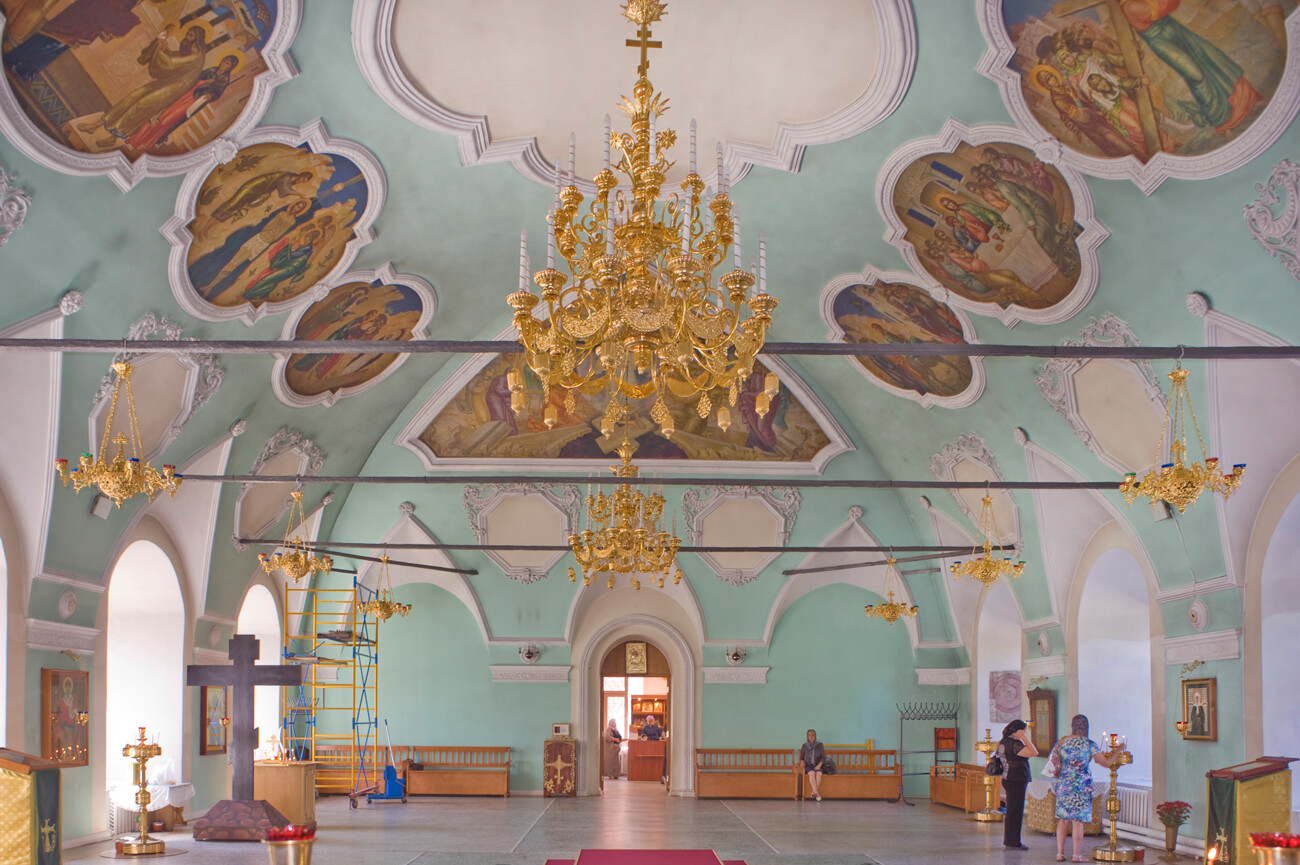
Upper Petrovsky Monastery. Refectory Church of Saint Sergius of Radonezh. Interior, view west from refectory hall toward narthex. Photo: August 22, 2015
William BrumfieldThe Vysoko-Petrovsky monastery was again devastated in 1611 during the Polish occupation of Moscow during the Time of Troubles, a dynastic crisis compounded by a civil war and social upheavals that devastated much of European Russia. The cathedral survived, and the monastery’s restoration, which began as early as 1612, included the construction of a brick wall.
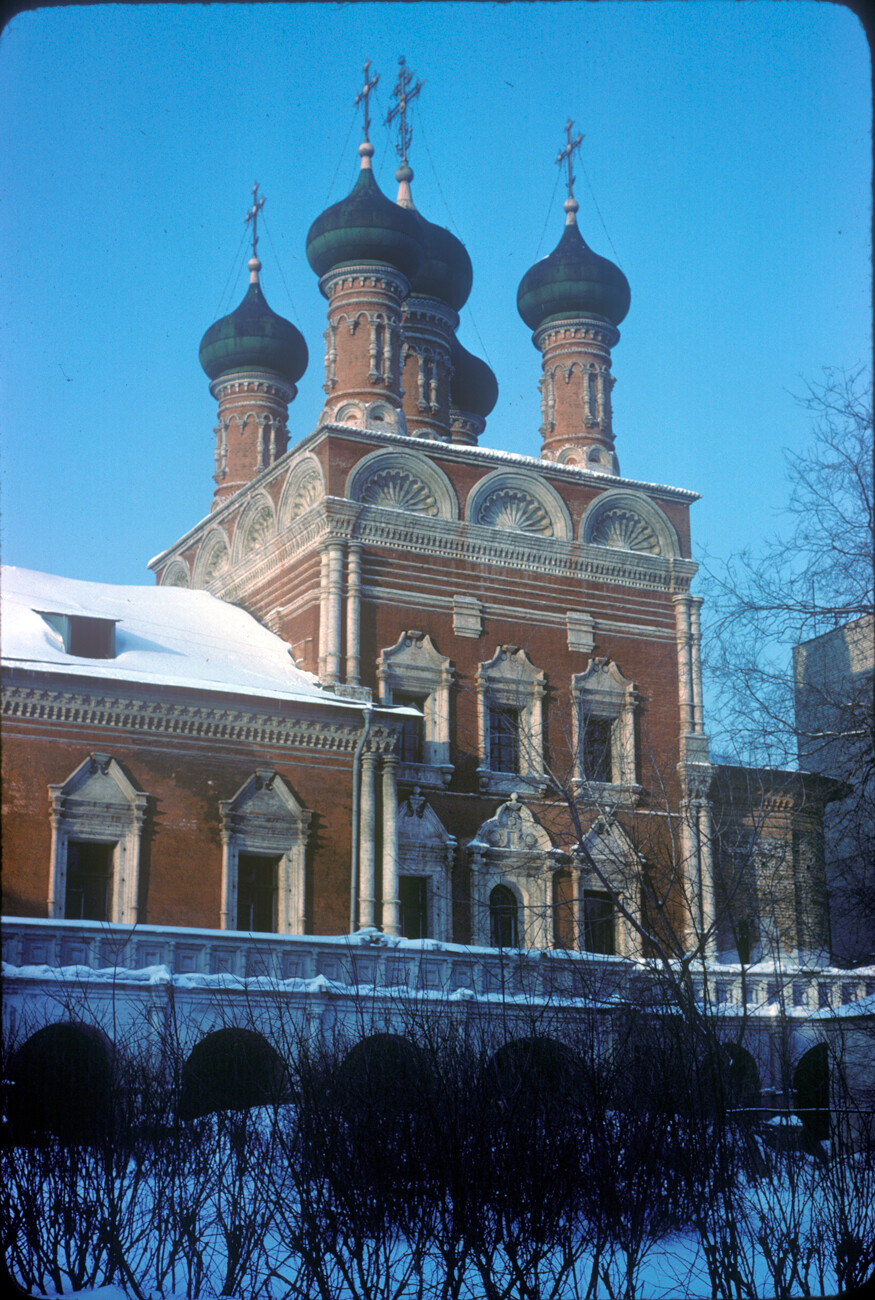
Upper Petrovsky Monastery. Refectory Church of Saint Sergius of Radonezh, southwest view before restoration. Photo: February 11, 1980
William BrumfieldIn the latter part of the 17th century the dramatic rise in the monastery’s fortunes was closely connected to the Naryshkin family, beginning with Kirill Naryshkin, whose daughter Natalya was the second wife of Tsar Aleksey Mikhailovich. With the birth of his grandson Peter in 1672, Kirill donated his Moscow estate to the tsar, who promptly transferred it to the adjoining Vysoko-Petrovsky Monastery, thus doubling its territory.
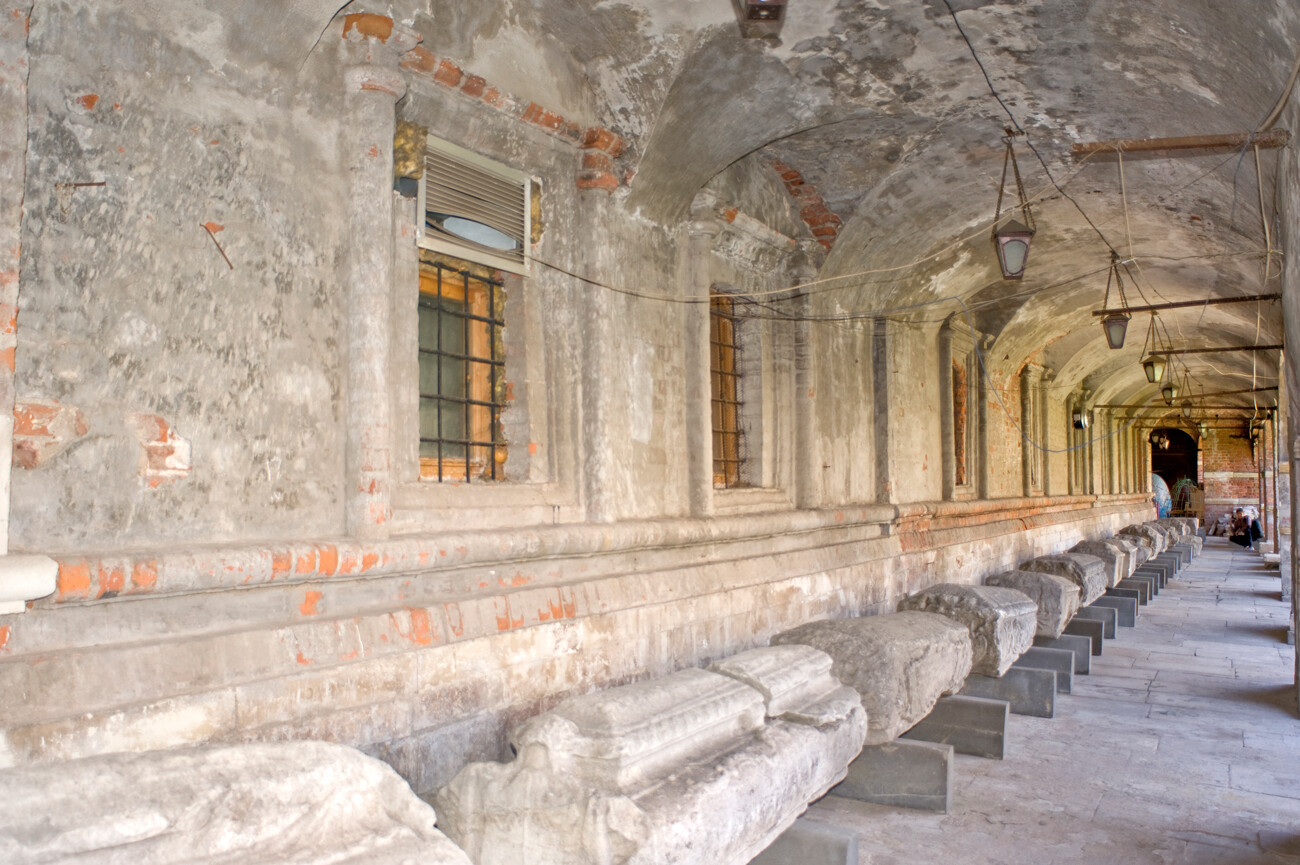
Upper Petrovsky Monastery. Refectory Church of Saint Sergius of Radonezh. South facade, ground level gallery with excavated 17th-century sarcophagi from monastery cemetery. Photo: August 2, 2015
William BrumfieldAfter the death of Aleksey Mikhailovich in 1676, Feodor – his son by his first marriage, to Maria Miloslavsky – ruled briefly, but Feodor’s death in 1682 created a complicated situation. The surviving heirs – Ivan V, Aleksey’s sickly youngest son from his first marriage, and Peter I, son from his second marriage – were still too young to rule, yet each was supported as heir by the competing Miloslavsky and Naryshkin clans. Seeing the greater health of Peter, the boyar council and Patriarch Joachim, leader of the Russian Orthodox Church, proclaimed Peter the tsar.
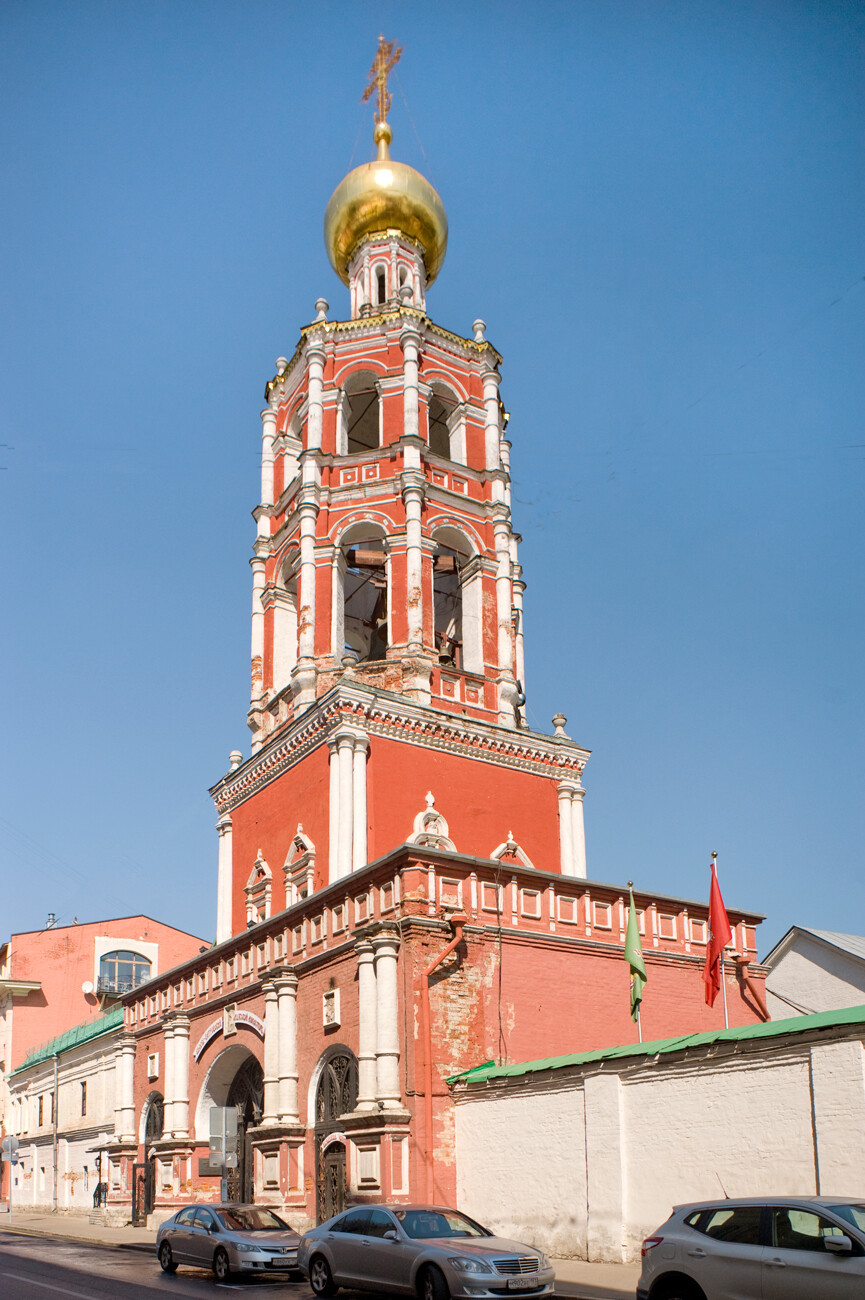
Upper Petrovsky Monastery. Bell tower with Gate Church of Intercession, southwest view Photo: August 22, 2015
William BrumfieldHowever, a revolt in April-May 1682 by disgruntled soldiers known as streltsy led to the granting of regency powers to Sophia, Tsar Aleksey’s daughter from his first marriage. Sophia and her faction were able to persuade the Patriarch to proclaim Ivan and Peter co-tsars. During this violent episode, Kirill Naryshkin’s sons Ivan and Afanasy were killed in the Kremlin in the presence of young Peter, their nephew, as the Miloslavsky family gained temporary ascendancy over the Naryshkins. The murdered Naryshkin brothers were buried at Vysoko-Petrovsky Monastery, and Kirill was forced to become a monk at the northern Kirill-Belozersky Monastery.
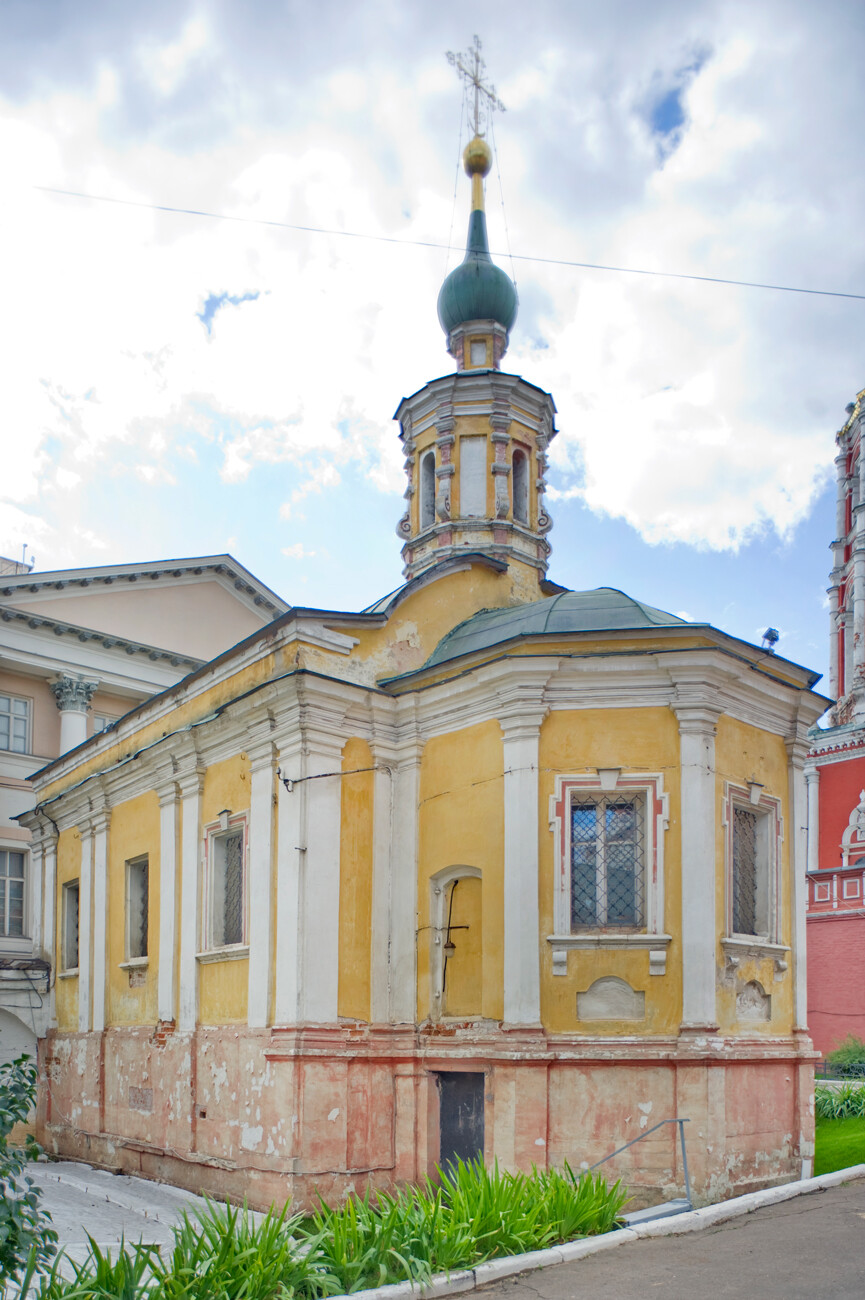
Upper Petrovsky Monastery. Church of the Tolg Icon of the Virgin, southeast view. Photo: August 2, 2015
William BrumfieldTo commemorate her brothers, Natalya Naryshkina supported the construction of a new brick Cathedral of the Bogolyubsky Icon of the Virgin (1684-1690) on the site of previous wooden churches, the earliest of which was built by Dmitry Donskoy in 1382. Although the interior was thoroughly ransacked during the Soviet period, the exterior has been well restored. Next to the southwest corner is a Naryshkin burial chapel.
During her reign, Sophia also bestowed favors on the Vysoko-Petrovsky Monastery. Increasingly fearful of the power of her half-brother Peter and assured of the debility of her brother Ivan, Sophia attempted a coup in 1689, again with the support of the streltsy.
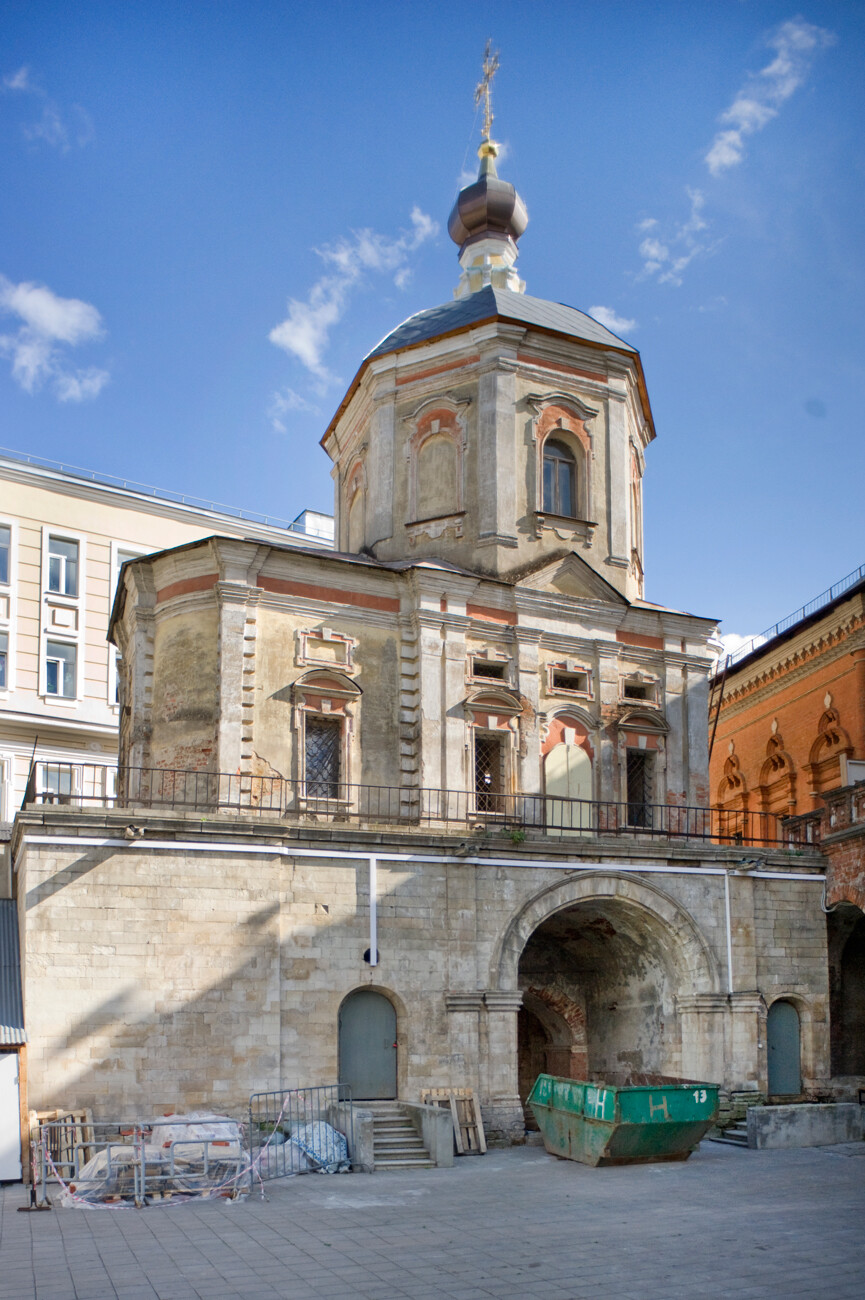
Upper Petrovsky Monastery. Church of St. Pachomius the Great, northeast view. Photo: August 2, 2015
William BrumfieldIn the wake of its failure and the triumph of young Peter I, Sophia was placed in confinement at Novodevichy Convent. The streltsy regiments were disbanded, and many of their number were tortured and executed by Peter, who remembered all too well the murder of his uncles.
Following the suppression of the 1689 uprising Peter commissioned the refectory Church of St. Sergius Radonezh at the Vysoko-Petrovsky Monastery in memory of his refuge at the Trinity-St. Sergius Monastery during the streltsy uprising. Completed in 1693, the church exemplifies the festive decorative style often referred to as ‘Naryshkin Baroque’.
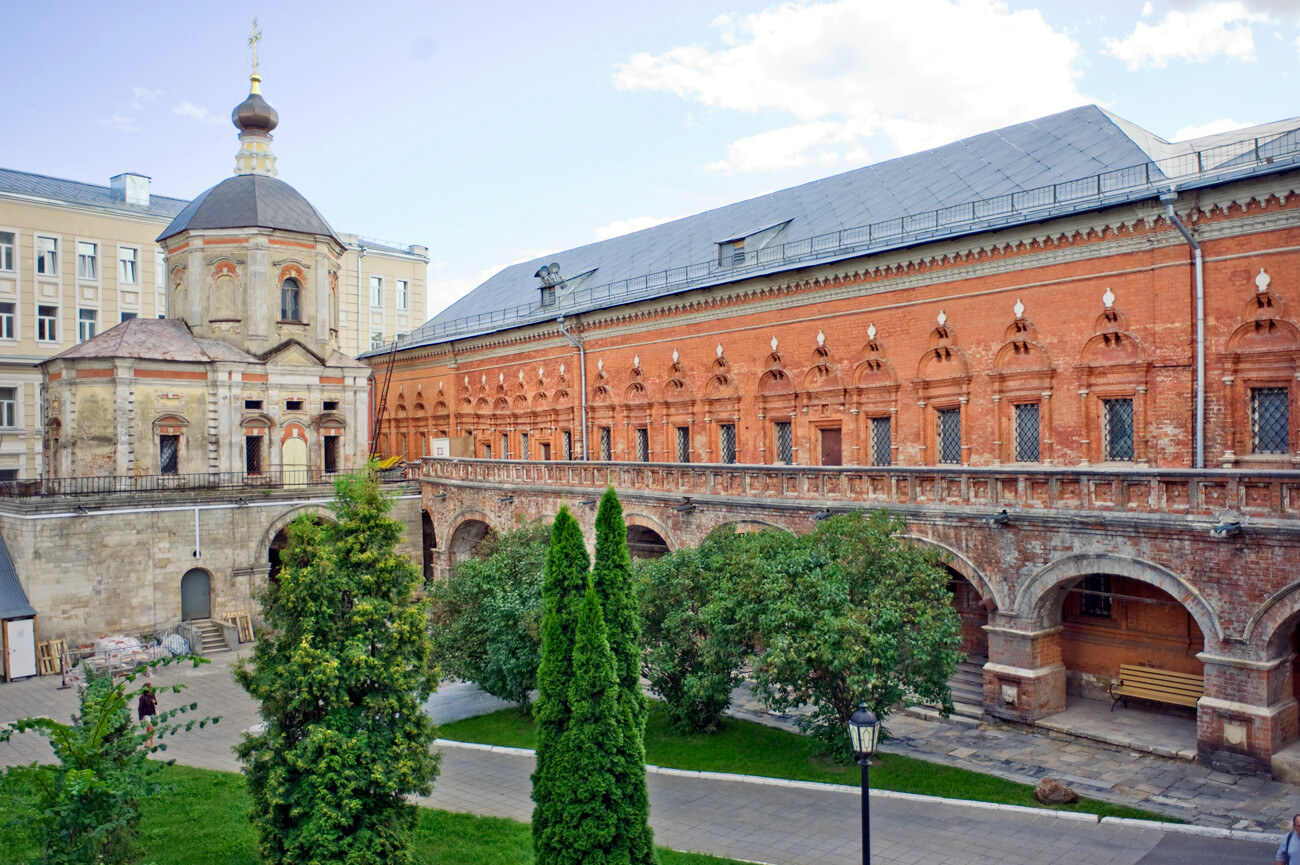
Upper Petrovsky Monastery. Cloisters, east facade with Church of St. Pachomius the Great (left). Photo: August 2, 2015
William BrumfieldIn 1696, work was also completed on the monastery bell tower, placed above the gate Church of the Intercession. The open arcading of the two-tiered octagonal tower over the gate church is a daring exercise in structural design with wide openings that disseminate the bell sounds. Like the other monastery structures of this period, the bell tower is brightly decorated and has long been a landmark in central Moscow.
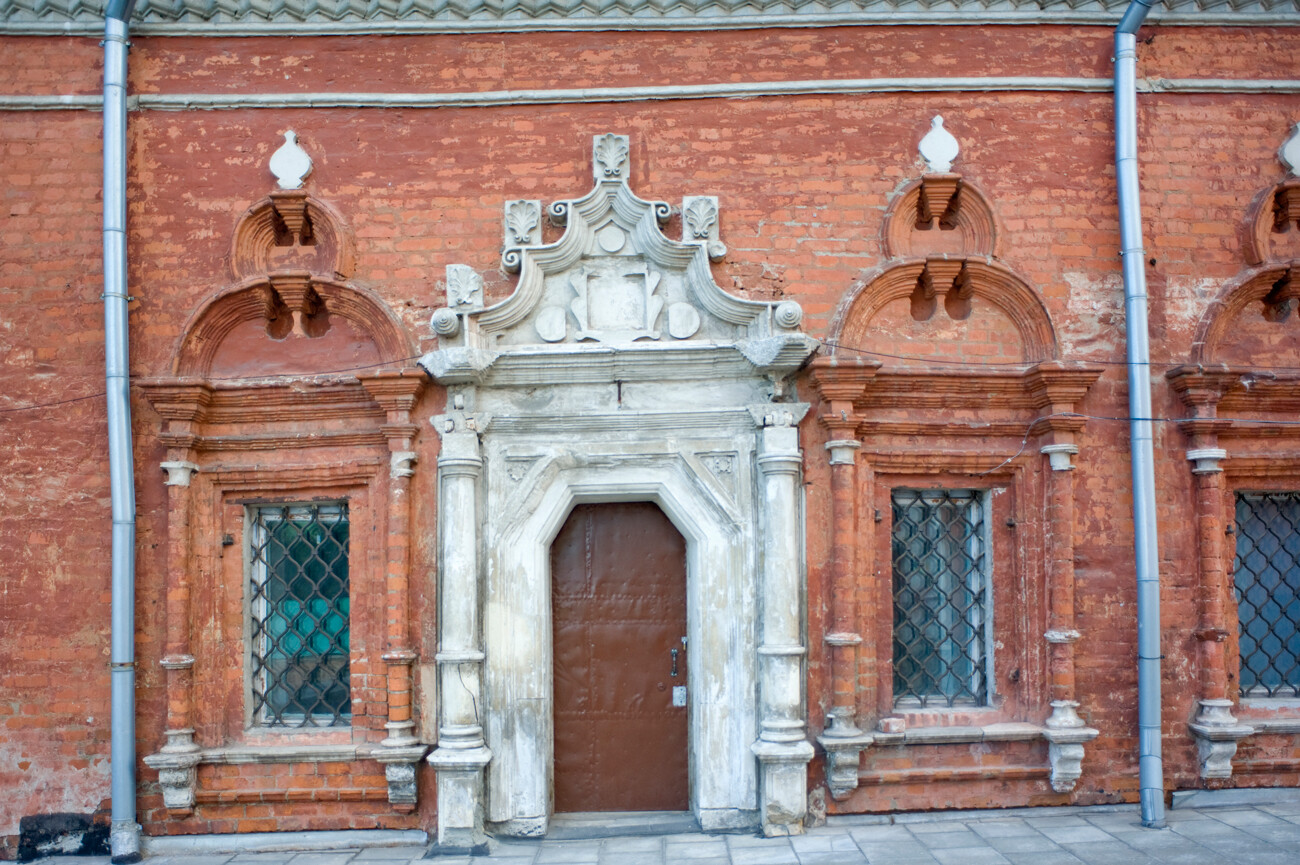
Upper Petrovsky Monastery. Cloisters, east facade with decorative limestone portal. Photo: August 2, 2015
William BrumfieldThe monastery’s largest component, completed in the 1690s, was the brick cloister building known as the ‘Naryshkin Chambers’ because of its association with Natalya Naryshkin, mother of Tsar Peter. Its long red façade with decorative windows forms a distinctive part of Petrovka Street. In the late 19th century, the cloisters were extended by the construction of a multi-storied building with a polychrome brick façade.
The 18th century brought small additions to the monastic ensemble, such as the Church of the Tolg Icon of the Virgin (1744-50), whose Baroque façade forms part of the monastery wall on Petrovka Street. Soon thereafter, in 1750-55, the Church of Saint Pachomius the Great was erected over the monastery’s south gate.
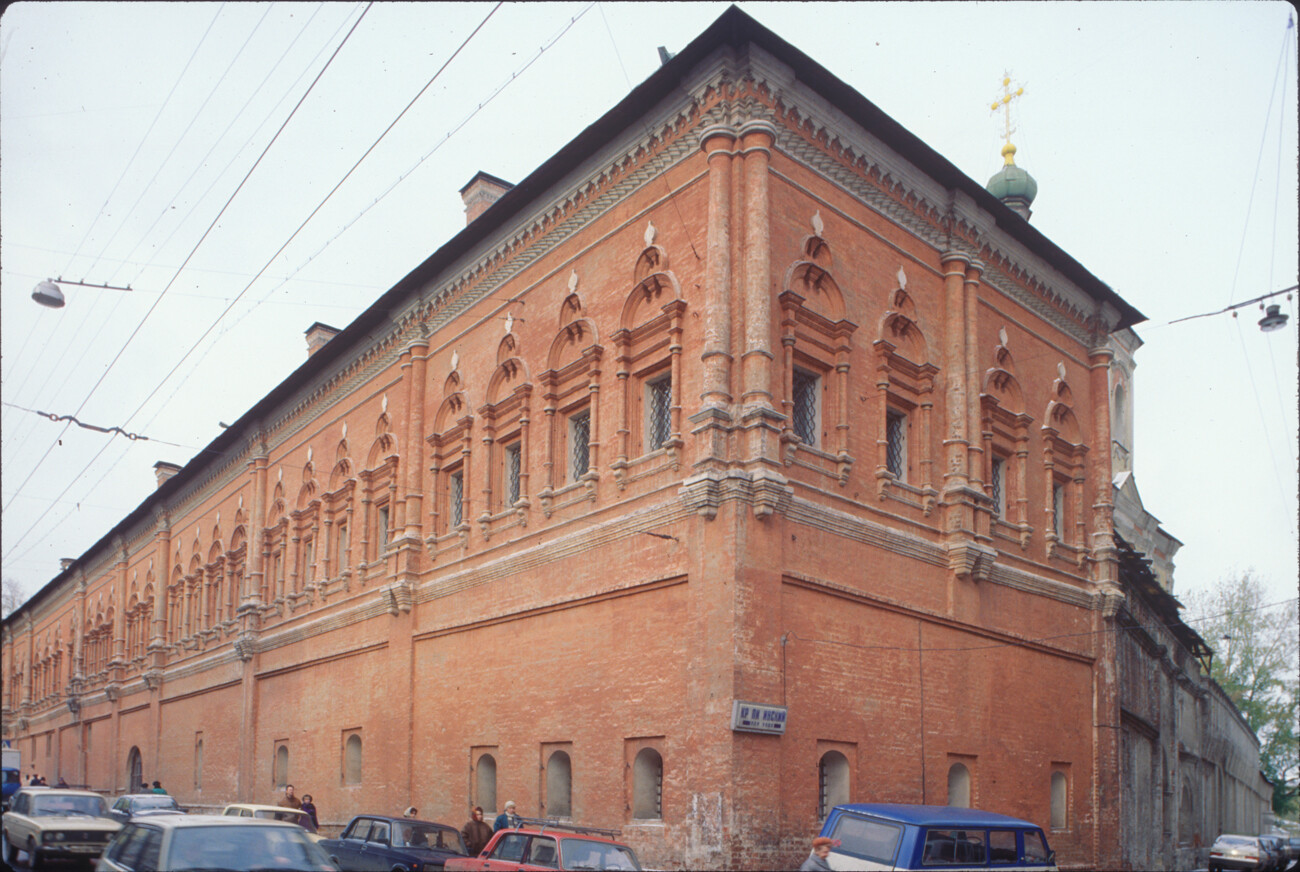
Upper Petrovsky Monastery. Cloisters, Petrovka Street facade. Photo: October 16, 1992
William BrumfieldThe Vysoko-Petrovsky Monastery had a grim fate during the Napoleonic occupation of Moscow in 1812. Although many valuables had been evacuated to Yaroslavl, the monastery churches were desecrated, and French authorities held tribunals that condemned many to death on suspicion of arson. Those executed were buried near the bell tower.
After its revival the monastery became a major center for religious education and publishing in Moscow. With the establishment of Soviet power, the monastery briefly functioned as a refuge for clerics driven from other institutions, but, in 1926, it, too, was closed. Severe damage was inflicted on the buildings (as documented in my photographs), and only in the 1950s was it recognized as a cultural monument to be preserved.
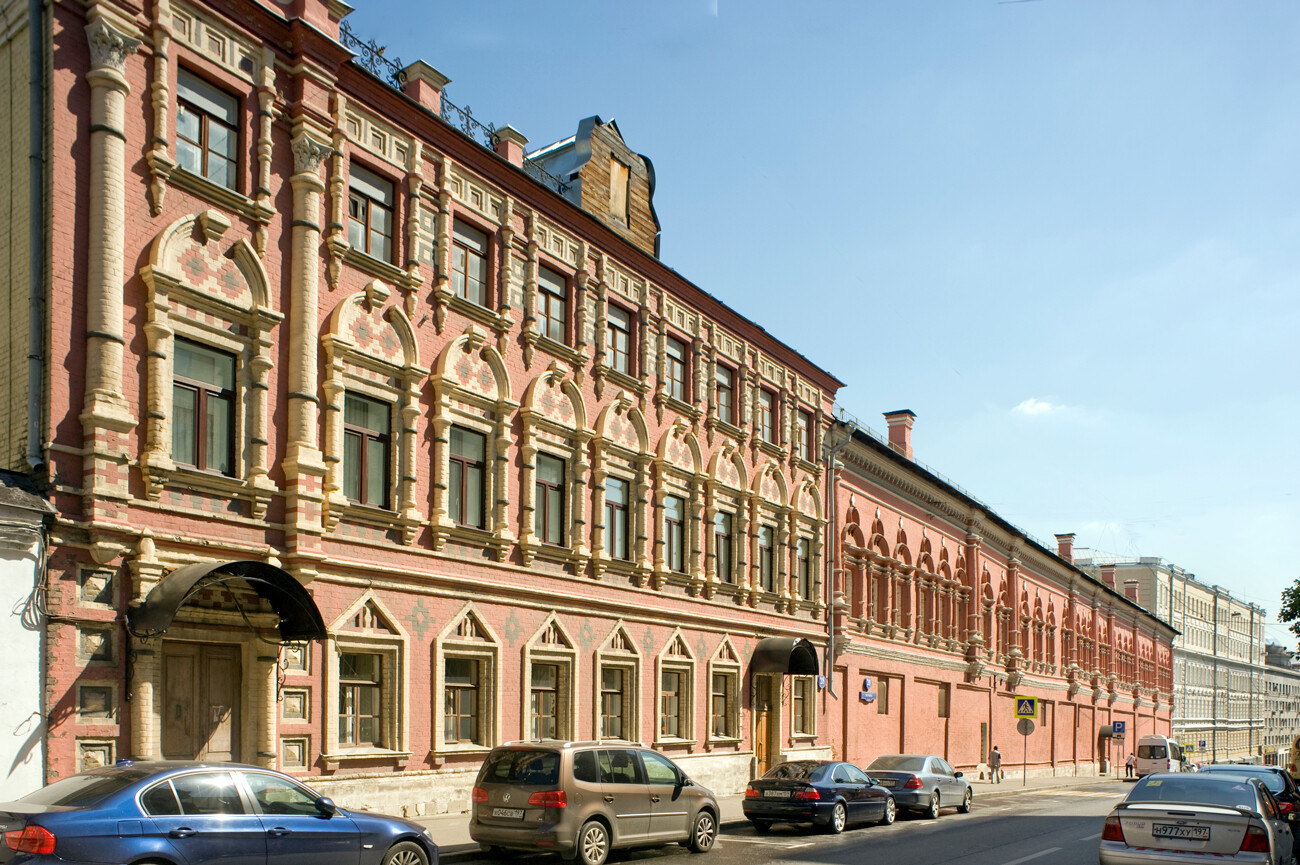
Upper Petrovsky Monastery. Cloisters, Petrovka Street facade with New Cloisters (left). Photo: August 22, 2015
William BrumfieldIn 1992, services resumed in the Church of St. Sergius of Radonezh. Since then, this monastery in homage to Metropolitan Peter has undertaken an ongoing program of restoration that has created an oasis in the center of Moscow.
In the early 20th century, Russian photographer Sergey Prokudin-Gorsky developed a complex process for color photography. Between 1903 and 1916, he traveled through the Russian Empire and took over 2,000 photographs with the process, which involved three exposures on a glass plate. In August 1918, he left Russia and ultimately resettled in France where he was reunited with a large part of his collection of glass negatives, as well as 13 albums of contact prints. After his death in Paris in 1944, his heirs sold the collection to the Library of Congress. In the early 21st century, the Library digitized the Prokudin-Gorsky Collection and made it freely available to the global public. A few Russian websites now have versions of the collection. In 1986, architectural historian and photographer William Brumfield organized the first exhibit of Prokudin-Gorsky photographs at the Library of Congress. Over a period of work in Russia beginning in 1970, Brumfield has photographed most of the sites visited by Prokudin-Gorsky. This series of articles juxtaposes Prokudin-Gorsky’s views of architectural monuments with photographs taken by Brumfield decades later.
If using any of Russia Beyond's content, partly or in full, always provide an active hyperlink to the original material.
Subscribe
to our newsletter!
Get the week's best stories straight to your inbox